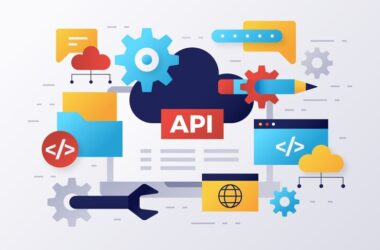In our quick-moving market, staying agile and responsive is key. Refactoring legacy code is vital for businesses stuck with old systems. These systems often can’t work well with new, cloud-based technologies. This puts them at risk of falling behind.
By 2025, Gartner says that nearly all new digital tasks will be on the cloud. Forbes notes that 77% of companies already use cloud services in some way. The shift starts with turning old, single-block systems into separate, cloud-friendly microservices. This makes apps work better in the cloud and cuts down on unnecessary coding. This process helps lessen technical debt.
Key Takeaways
- Refactoring legacy code is crucial for staying ahead in today’s market.
- Outdated systems are tough to mix with modern, cloud-based tech.
- Almost all new digital work will be on the cloud by 2025.
- Switching to microservices is key for better code.
- This method reduces unnecessary coding and lessens technical debt.
Understanding the Importance of Refactoring Legacy Code
Refactoring legacy code is crucial for keeping the codebase strong and making software run better. It involves reshaping existing code to enhance maintainability. This does not change how the code works outside.
Definition and Goals of Code Refactoring
Code refactoring restructures code to better its internal structure without altering its external actions. This simplification makes the code less complicated. The main aim is to make the code work smoother and last longer.
Benefits of Refactoring Legacy Code
Refactoring has many benefits, like better maintainability and stronger codebase sustainability. According to Agile Alliance, it cleans and simplifies code. This makes updates easier and fits agile software development. It also helps cloud integration, boosting app performance.
Refactoring legacy code can also increase performance significantly. For example, Google improves its systems by periodically refactoring. This keeps applications strong against tech changes.
Common Challenges in Legacy Codebases
Legacy codebases are like old houses—full of history but also problems. They struggle with issues like outdated tech, missing documentation, and scalability. These problems make updating old code tough, needing a lot of time and effort.
Outdated Technologies
The biggest issue with legacy systems is their old technology. As new tech comes out, old systems fall behind. This can harm a company’s competitive edge. To fix this, updating code and using modern tech is key.
Lack of Documentation
Another big problem is the lack of documentation. Over time, code changes often aren’t well recorded. This makes it hard for new developers to understand and improve the system. Good documentation is crucial for fixing these issues.
Scalability Issues
Scalability is also a major challenge. Old systems weren’t made to handle today’s data loads or user numbers. To deal with this, code must be made more flexible and adaptable. This allows the system to meet growing business needs.
To modernize legacy systems successfully, a broad strategy is needed. Addressing outdated tech, poor documentation, and scalability is vital. This helps overcome the common limitations of old codebases.
Strategies to Identify Code Smells and Anti-Patterns
Exploring old codebases requires alertness for code smells and anti-patterns. Spotting these early can lead to effective refactoring. This improves code quality drastically.
Common Code Smells
Code smells signal deeper issues. Examples include duplicated code, oversized classes, and lengthy methods. Identifying these helps pinpoint where improvements are needed.
Identifying Anti-Patterns
Anti-patterns are poor solutions to frequent problems. They include ‘spaghetti code’ and ‘god object’. Finding these is key to fixing bad design choices.
Using Automated Code Analysis Tools
Tools like static analyzers are great for checking code systematically. They help find problems quickly. This improves the code quality where it’s most needed.
Techniques for Modernizing Legacy Code
Modernizing legacy code is key for businesses wanting to stay agile today. There are several methods to transform old systems into strong, modern infrastructures.
Incremental Refactoring
Incremental refactoring allows for gradual code improvement without overloading the team. By making small changes step by step, operations keep going while the code gets better. Netflix used this approach in their cloud upgrade, enhancing scalability and performance.
Modularization
System modularization is crucial in updating old code. It involves breaking big apps into smaller parts. This makes development smoother and integration with new tech easier. Each part works on its own, making things flexible and simple to update.
Updating Technologies
Adopting new software technologies is vital for reviving old systems. Updating old frameworks, languages, and tools boosts performance and security. This helps legacy systems keep up with new tech changes, staying useful in today’s digital world.
The Role of Cloud-Native Architecture in Refactoring
Moving to a cloud-native setup through microservices adoption is key in updating old systems. It boosts speed while also increasing flexibility and reducing costs. But, it’s critical to manage cloud transition challenges to transform successfully.
Transitioning to Microservices
Switching to a cloud-native framework means dividing big apps into smaller, self-sufficient services called microservices. This way, apps can grow, be easy to handle, and be developed quicker. It lets teams work on different parts at the same time, enabling steady delivery and deployment.
Benefits of Cloud-Native Systems
Cloud-native setups offer many perks, improving system agility and the ability to scale. They allow for auto scaling, more robustness, and quicker launch times. Benefits also include less spending on resources and better efficiency, as seen with companies like Netflix and Google.
Challenges in Implementing Cloud-Native Architecture
Even with its benefits, shifting to cloud-native architecture comes with obstacles. A big challenge is redoing the whole app design for the best cloud performance. It’s a complete architectural shift. Overcoming these challenges means tackling data security, managing dependencies, and making sure microservices work well together.
In the end, moving to a cloud-native setup and using microservices adoption means we enjoy huge benefits despite the challenges. It results in a strong, flexible system that’s up for future tech needs.
Best Practices for Effective Code Refactoring
It’s vital to follow best practices in code refactoring to keep software working well. This makes it easier to update code and improves the development process.
Implementing Rigorous Testing
Starting with rigorous testing is key for good code refactoring. It’s about doing a lot of tests to make sure no bugs sneak in. Tests check that everything still works like before.
Balancing Time and Budget
It’s also important to manage your time and money well when refactoring. Plan carefully to avoid extra costs or delays. Continuous planning lets refactoring fit smoothly into regular work.
Team Collaboration and Knowledge Sharing
Working well together is essential for refactoring success. Sharing knowledge helps spread good practices among the team. This teamwork leads to better code and a culture of always getting better.
The Process of Transforming Monolithic Applications
Changing old applications into modern setups is very important. It helps them perform better and stay flexible in our fast tech world.
Breaking Down Monoliths into Microservices
When we break big apps into smaller services, it’s easier to update them and fix issues. We find the main parts and split them into smaller, independent services. This way, each part can be worked on and improved by itself.
Ensuring Seamless Integration
After breaking apps into services, they need to work together smoothly. We use APIs for communication between services. It’s important that they speak the same language and follow the same rules to work well together.
Maintaining Code Integrity
It’s critical to keep the code’s quality high during changes. By constantly testing and reviewing the code, we make sure it stays reliable. Following good coding practices keeps the new services running well and free from errors.
Using Test-Driven Development (TDD) for Refactoring
Adopting TDD methodology changes how we tackle refactoring, making it more structured. This boosts both the speed and sureness of development. By first writing tests, then updating code, it guarantees new changes don’t mess up what was working before.
Principles of TDD
TDD’s main principles are based on a simple, strict cycle: Red, Green, Refactor. It begins with a test that fails (Red). Next, you write enough code to pass this test (Green). Then, you improve the code without changing its function (Refactor). This cycle not only ensures the code is reliable but also continuously improves its quality.
Creating a Robust Test Suite
Having a full set of tests is key for confident refactoring. It should include unit, integration, and system tests to check every part of the app. Using stubs and mocks lets us test parts separately. This makes refactoring both quicker and more trustworthy.
Benefits of TDD in Refactoring
Using TDD methodology for refactoring has many benefits. It helps find errors early, leads to neater code and design, and boosts teamwork. Plus, TDD means even small changes are checked, keeping the code reliable all the time.
Advanced Strategies for Refactoring Legacy Code
Refactoring legacy code is getting more complex as we explore deeper. New methods not only change the structure but also improve the code’s maintainability and efficiency. Key strategies include using design patterns, breaking dependencies, and applying dependency injection.
Leveraging Design Patterns
Design patterns offer solid, reusable solutions for common issues in legacy systems. They make the code structure better, leading to easier maintenance. This is really important for old systems with complex logic. Picking the right patterns makes systems more scalable and reliable.
Breaking Dependencies
Legacy systems often have complicated dependencies, making updates hard. By breaking these dependencies carefully, we can simplify the system. This makes development more modular. It’s a key step in moving from a single, large system to a more flexible, service-oriented one.
Dependency Injection Techniques
Dependency injection makes providing dependencies dynamic, allowing for more adaptable and testable code. It helps legacy systems easily add new components. The perks include better modularity, clearer separation, and improved maintenance. This method is crucial for turning a stiff legacy system into something more modern and flexible.






